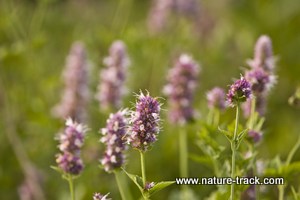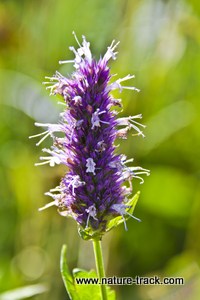Mint Family


The irregular and clustered flowers and long pairs of stamens make the giant hyssop easy to recognize even if you can’t smell the spicy aroma or see the square stalk.
Giant hyssop, sometimes called horsemint, lined sunny meadows on the trail to Aldous Lake near Kilgore last week. The purplish flowers were gathered in heavy tight clusters and standing atop square stems. Stamens jutted from the flower tubes and were clearly visible from a short distance. When I crushed a leaf and took a sniff, my nose was filled with a strong mint-like aroma. It was easy to determine that giant hyssop is a member of the mint family.
Being able to identify plants and their uses is basic to becoming a naturalist. Finding the characteristics that group plants into families is the first step. The mint family is a great place to start because their characteristics are easily recognizable.
Most of the approximately 7500 members of the mint family are fairly easy for even a beginning naturalist to identify to the family level. Just remember three things:
1—square stalks,
2—opposite leaves that cling to the stem with each pair at right angles to the previous one and,
3—usually a strong but pleasant aroma. This isn’t a flower fragrance but rather, a scent that permeates the entire plant.
There are a few other plants with square stalks such as the loosestrifes and verbena, but they are not aromatic. There are some very aromatic plants that are not mints. But put those three characteristics together and you are almost sure to have a mint.
Follow your curiosity and take a closer look at the flowers for more clues about the mint family. Sepals are fused together, almost to the tops. The four to five petals are also fused into a tube with just the tips separate. They are irregular (asymmetrical) flowers in that there are usually one to two petals on top and three on the bottom. There are usually four stamens but two are often considerably longer than the others and protrude noticeably from the corolla.
You are likely more familiar with the mint family than you might realize. Besides popular mints such as peppermint and spearmint, likely half the spices in your cabinet are from the mint family. For instance, the Italian favorites, basil, oregano and thyme all come from the mint family. In addition, rosemary, sage (culinary sage, not sagebrush), marjoram, lavender, hyssop and savory are on the mint family tree.
Volatile oils within the plants are responsible for their culinary attraction and for the strong heady aroma. Within the genus, Mentha, menthol is the most common oil. These oils are often found throughout the entire plant, not just in the flowers.
Mint family members are also common ornamental plants. For instance, salvia, coleus and ajuga all add color and unique form to my gardens. Bee balm, with its lemony smell is also a garden favorite, one that I enjoy as a cut-flower as much for its scent as for the color and unique shape.
In such a large family, you would expect a wide variety of plant types and habitat preferences. However, most are perennials herbs and prefer moist areas with moderate sunlight. Sunny creek-side meadows are perfect.
The mint family is easy to recognize and is a good place to start if you are new to botany and one every naturalist should know.

"WOW. What a phenomenal piece you wrote. You are amazing." Jennifer Jackson
That is embarrassing, but actually a fairly typical response to my nature essays. Since The Best of Nature is created from the very best of 16 years of these nature essays published weekly in the Idaho Falls Post Register (online readership 70,000), it is a fine read. It covers a wide variety of topics including humorous glimpses of nature, philosophy, natural history, and conservation. Readers praise the style, breadth of subject matter and my ability to communicate complex and emotional topics in a relaxed and understandable manner.
Everyone can find something to love in this book. From teenagers to octogenarians, from the coffee shop to the school room, these nature essays are widely read and enjoyed.
Some of the essays here are my personal favorites, others seemed to strike a chord with readers. Most have an important message or lesson that will resonate with you. They are written with a goal to simultaneously entertain and educate about the wonderful workings of nature. Some will make you laugh out loud and others will bring a tear to the eye and warm your heart.
Readers Write:
"You hit a home run with your article on, Big Questions in Nature. It should be required reading for everyone who has lost touch with nature...great job!" Joe Chapman
"We enjoyed your column, Bloom Where Planted. Some of the best writing yet. The Post Register is fortunate to have your weekly columns." Lou Griffin.
To read more and to order a copy, click here or get the Kindle version
Copies are also available at:
Post Register
Island Park Builders Supply (upstairs)
Barnes and Noble in Idaho Falls
Harriman State Park, Island Park
Museum of Idaho
Valley Books, Jackson Wyoming
Avocet Corner Bookstore, Bear River National Wildlife Refuge, Brigham City, Utah
Craters of the Moon National Monument Bookstore, Arco, Idaho